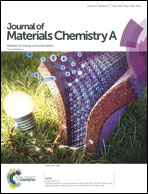Defect-rich (Co–CoS2)x@Co9S8 nanosheets derived from monomolecular precursor pyrolysis with excellent catalytic activity for hydrogen evolution reaction†
Abstract
The construction of defects in two-dimensional ultrathin nanosheets will improve the activity of transition metal-based catalysts. CoSx-based electrocatalysts have attracted increasing attention because of their low cost. In this article, defect-rich, Co9S8-based ultrathin nanosheets were synthesized through direct pyrolysis of cobalt dibutyl dithiocarbamate in organic amine solvents. Edge, cavity and dislocation defects exist in the as-obtained nanosheets. The nanosheets with thickness of 4–6 nm are composed mainly of Co9S8, with small amounts of Co and CoS2. The defects on Co9S8-based nanosheets were controlled by tuning the coordination solvents and pyrolysis parameters. The optimized nanosheets with defective structures have superior catalytic activity for hydrogen evolution reaction in acid media, with a low onset potential of 228 mV and Tafel slope of 51.0 mV dec−1. The catalyst displays robust stability without obvious degradation after being employed over 16 h. The pyrolysis of monomolecular precursors in an organic system provides a new way to construct transition metal compound-based, defect-rich nanostructures for electrocatalysis and energy storage.



 Please wait while we load your content...
Please wait while we load your content...